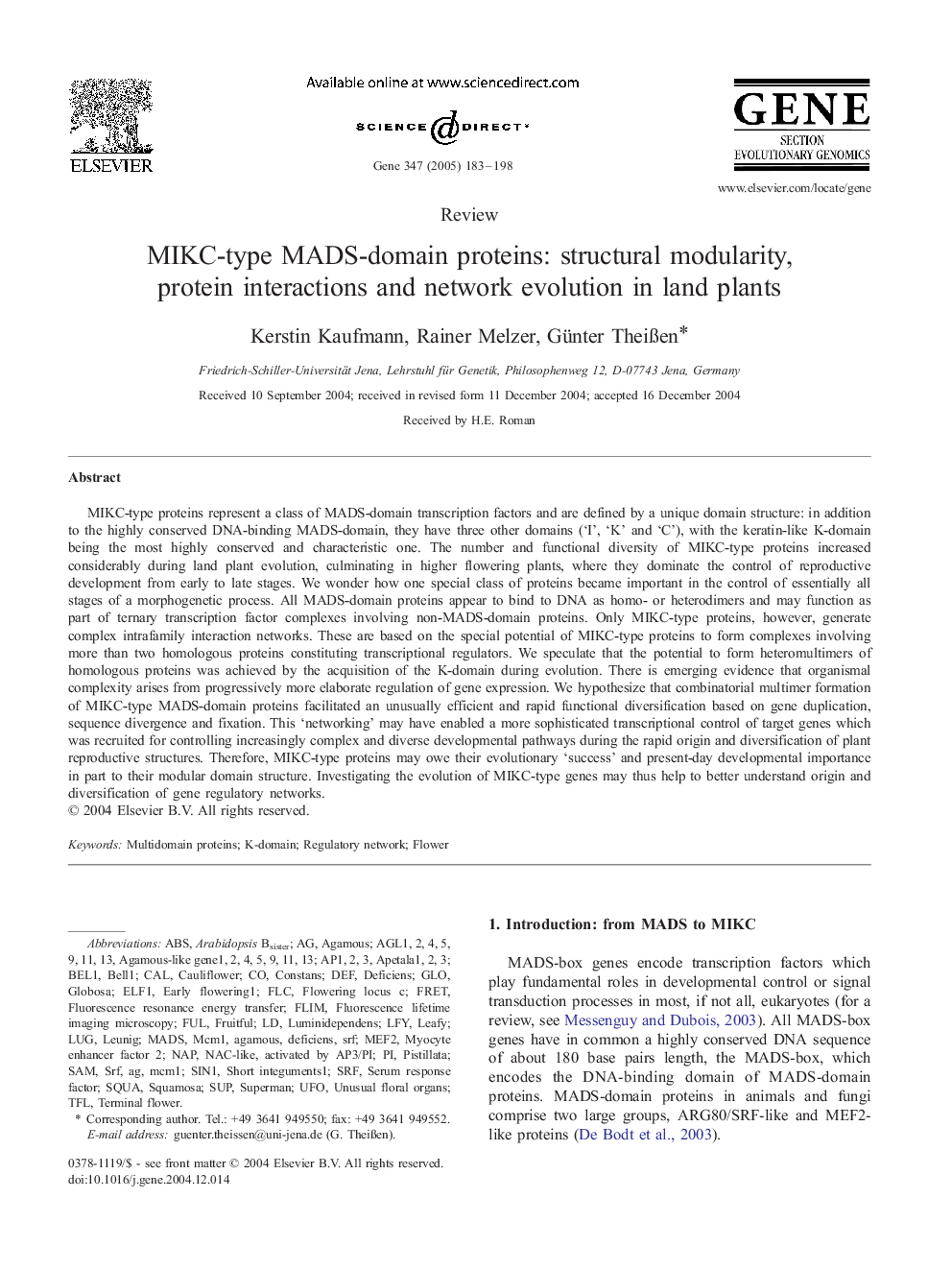| کد مقاله | کد نشریه | سال انتشار | مقاله انگلیسی | نسخه تمام متن |
|---|---|---|---|---|
| 9127320 | 1160209 | 2005 | 16 صفحه PDF | دانلود رایگان |
عنوان انگلیسی مقاله ISI
MIKC-type MADS-domain proteins: structural modularity, protein interactions and network evolution in land plants
دانلود مقاله + سفارش ترجمه
دانلود مقاله ISI انگلیسی
رایگان برای ایرانیان
کلمات کلیدی
FLCUNUSUAL FLORAL ORGANSLuminidependensSIN1LugUFOMADSK-domainLFYFULMEF2DEFSRFNAPABSSAMTFLFLIM - FL منFluorescence resonance energy transfer - انتقال انرژی رزونانس FluorescenceFRET - انتقال انرژی رزونانسی فورسترAGAMOUS - انعطاف پذیرLEAFY - برگDEFICIENS - زوالSup - سوپSuperman - سوپرمنregulatory network - شبکه نظارتیmyocyte enhancer factor 2 - فاکتور افزایش دهنده myocyte 2serum response factor - فاکتور پاسخ سرمیfluorescence lifetime imaging microscopy - میکروسکوپ تصویربرداری طول عمر فلورسنتmultidomain proteins - پروتئین های چند دامنهPISTILLATA - پسته، pista LATAcal - کالCONSTANS - کنستانسFlower - گلFLOWERING LOCUS C - گل LOCUS CCauliflower - گل کلمGlo - گلو
موضوعات مرتبط
علوم زیستی و بیوفناوری
بیوشیمی، ژنتیک و زیست شناسی مولکولی
ژنتیک
پیش نمایش صفحه اول مقاله

چکیده انگلیسی
MIKC-type proteins represent a class of MADS-domain transcription factors and are defined by a unique domain structure: in addition to the highly conserved DNA-binding MADS-domain, they have three other domains ('I', 'K' and 'C'), with the keratin-like K-domain being the most highly conserved and characteristic one. The number and functional diversity of MIKC-type proteins increased considerably during land plant evolution, culminating in higher flowering plants, where they dominate the control of reproductive development from early to late stages. We wonder how one special class of proteins became important in the control of essentially all stages of a morphogenetic process. All MADS-domain proteins appear to bind to DNA as homo- or heterodimers and may function as part of ternary transcription factor complexes involving non-MADS-domain proteins. Only MIKC-type proteins, however, generate complex intrafamily interaction networks. These are based on the special potential of MIKC-type proteins to form complexes involving more than two homologous proteins constituting transcriptional regulators. We speculate that the potential to form heteromultimers of homologous proteins was achieved by the acquisition of the K-domain during evolution. There is emerging evidence that organismal complexity arises from progressively more elaborate regulation of gene expression. We hypothesize that combinatorial multimer formation of MIKC-type MADS-domain proteins facilitated an unusually efficient and rapid functional diversification based on gene duplication, sequence divergence and fixation. This 'networking' may have enabled a more sophisticated transcriptional control of target genes which was recruited for controlling increasingly complex and diverse developmental pathways during the rapid origin and diversification of plant reproductive structures. Therefore, MIKC-type proteins may owe their evolutionary 'success' and present-day developmental importance in part to their modular domain structure. Investigating the evolution of MIKC-type genes may thus help to better understand origin and diversification of gene regulatory networks.
ناشر
Database: Elsevier - ScienceDirect (ساینس دایرکت)
Journal: Gene - Volume 347, Issue 2, 14 March 2005, Pages 183-198
Journal: Gene - Volume 347, Issue 2, 14 March 2005, Pages 183-198
نویسندگان
Kerstin Kaufmann, Rainer Melzer, Günter TheiÃen,